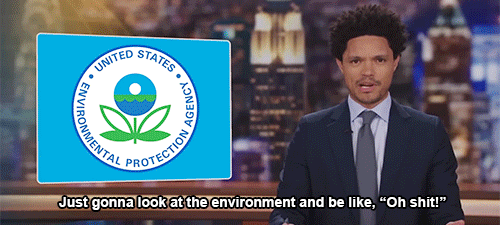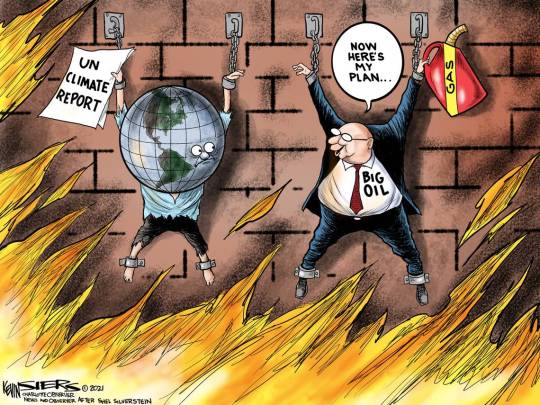#Environmental Protection Agency (EPA)
Text
"The sleeping giant of the US Environmental Protection Agency (EPA) has stirred.
In the past month, an avalanche of anti-pollution rules, targeting everything from toxic drinking water to planet-heating gases in the atmosphere, have been issued by the agency. Belatedly, the sizable weight of the US federal government is being thrown at longstanding environmental crises, including the climate emergency.
On Thursday [May 18, 2023], the EPA’s month of frenzied activity was crowned by the toughest ever limits upon carbon pollution from America’s power sector, with large, existing coal and gas plants told they must slash their emissions by 90% or face being shut down.
The measure will, the EPA says, wipe out more than 600m tons of carbon emissions over the next two decades, about double what the entire UK emits each year. But even this wasn’t the biggest pollution reduction announced in recent weeks.
In April, new emissions standards for cars and trucks will eliminate an expected 9bn tons of CO2 by the mid-point of the century, while separate rules issued late last year aim to slash hydrofluorocarbons, planet-heating gases used widely in refrigeration and air conditioning, by 4.6bn tons in the same timeframe. Methane, another highly potent greenhouse gas, will be curtailed by 810m tons over the next decade in another EPA edict.
In just a few short months the EPA, diminished and demoralized under Donald Trump, has flexed its regulatory muscles to the extent that 15bn tons of greenhouse gases – equivalent to about three times the US’s carbon pollution, or nearly half of the entire world’s annual fossil fuel emissions – are set to be prevented, transforming the power basis of Americans’ cars and homes in the process...
If last year’s Inflation Reduction Act (IRA), with its $370bn in clean energy subsidies and enticements for electric car buyers, was the carrot to reducing emissions, the EPA now appears to be bringing a hefty stick.
The IRA should help reduce US emissions by about 40% this decade but the cut needs to be deeper, up to half of 2005 levels, to give the world a chance of avoiding catastrophic heatwaves, wildfires, drought and other climate calamities. The new rules suddenly put America, after years of delay and political rancor, tantalizingly within reach of this...

“It’s clear we’ve reached a pivotal point in human history and it’s on all of us to act right now to protect our future,” said Michael Regan, the administrator of the EPA, in a speech last week at the University of Maryland. The venue was chosen in a nod to the young, climate-concerned voters Joe Biden hopes to court in next year’s presidential election, and who have been dismayed by Biden’s acquiescence to large-scale oil and gas drilling.
“Folks, this is our future we are talking about, and we have a once-in-a-generation opportunity for real climate action,” [Michael Regan, the administrator of the EPA], added. “Failure is not an option, indifference is not an option, inaction is not an option.” ...
It’s not just climate the EPA has acted upon in recent months. There are new standards for chemical plants, such as those that blight the so-called "Cancer Alley" the US, from emitting cancer-causing toxins such as benzene, ethylene oxide and vinyl chloride. New rules curbing mercury, arsenic and lead from industrial facilities have been released, as have tighter limits on emissions of soot and the first ever regulations targeting the presence of per- and polyfluoroalkylsubstances (or PFAS) in drinking water.” ...
For those inside the agency, the breakneck pace has been enervating. “It’s definitely a race against time,” said one senior EPA official, who asked not to be named. “The clock is ticking. It is a sprint through a marathon and it is exhausting.” ...
“We know the work to confront the climate crisis doesn’t stop at strong carbon pollution standards,” said Ben Jealous, the executive director of the Sierra Club.
“The continued use or expansion of fossil power plants is incompatible with a livable future. Simply put, we must not merely limit the use of fossil fuel electricity – we must end it entirely.”"
-via The Guardian (US), 5/16/23
#epa#environmental protection agency#united states#us politics#coal#cw cancer mention#pfas#sustainability#carbon emissions#good news#hope
6K notes
·
View notes
Text

Earth Day History
Earth Day, first observed on 22 April 1970, is considered the beginning of the modern environmental movement.
As a response to increasing environmental concerns, like the oil spill in Santa Barbara in 1969, U.S. Senator Gaylord Nelson founded Earth Day to raise awareness about how to protect the environment.
Nelson and activist Denis Hayes organized teach-ins on college campuses that included various groups and organizations, drawing inspiration from protest teach-ins of the era.
With this massive mobilization, the U.S. developed key environmental laws and the Environmental Protection Agency (EPA) was created.

Earth Day 2024 Theme
The theme of Earth Day 2024 is “Planet vs. Plastics.”
This is about fighting the big problem of plastic all over the world. Earth Day organization wants to bring people from different places together.
The goal is to make much less plastic, 60% less by 2040.
We want a future without so much plastic. This is not just about having less trash, but it is also about keeping us and the environment healthy.
#Earth Day#Earth Day 2024#environmental movement#environmental concerns#U.S. Senator Gaylord Nelson#Denis Hayes#Environmental Protection Agency (EPA)#Planet vs. Plastics#environmental laws#environment#save mother earth
118 notes
·
View notes
Text








6.30.22
#i hate it here#the daily show#trevor noah#epa#environmental protection agency#SCOTUS#biden#television#gif#popular
2K notes
·
View notes
Photo

Hazy Cleveland skyline on July 20, 1973, day of a pollution alert.
Record Group 412: Records of the Environmental Protection Agency
Series: DOCUMERICA: The Environmental Protection Agency's Program to Photographically Document Subjects of Environmental Concern
Image description: The Cleveland skyline, with the furthest buildings disappearing in haze. The entire photo, including the sky, is tinged yellow-orange.
104 notes
·
View notes
Photo

Rachel Carson was born on May 27, 1907. An American marine biologist, writer, and conservationist whose influential book Silent Spring (1962) and other writings are credited with advancing the global environmental movement. Although Silent Spring was met with fierce opposition by chemical companies, it spurred a reversal in national pesticide policy, which led to a nationwide ban on DDT and other pesticides. It also inspired a grassroots environmental movement that led to the creation of the U.S. Environmental Protection Agency.
#rachel carson#silent spring#environmentalists#environment#environmental protection#environmental protection agency#EPA#DDT#women in science#women in history#science#science history#science birthdays#on this day#on this day in science history
62 notes
·
View notes
Photo

September 1983 cover
Artist: George Woodbridge
#Mad magazine#cover#Alfred E. Neuman#surfing#garbage wave#Environmental Protection Agency#Alfred E Neuman#trash#environment#epa#1980s
205 notes
·
View notes
Text
US appeals court kills ban on plastic containers contaminated with PFAS
Republicans absolutely do not give a fuck about your health so long as it affects profitability. They don't give la shit if a company produces a product that causes health problems.
Republicans will pretend to care about mothers and fertility with their anti-abortion bullshit whilst simultaneously allowing companies to pump fertility-destroying teratogenic compounds into their products.
#environmental protection agency#epa#texas#republicans#pfas#pfas pollution#plastic#plastic products#industry#fertility#miscarriage#abortion#republican hypocrisy#united states#capitalism#corporate greed#cancer#carcinogens
10 notes
·
View notes
Text
#current events#thecooldown#pollution#climate crisis#kayrros#sky news#polluting leaks#methane#united states#russia#turkmenistan#australia#india#environmental protection agency#EPA#global methane pledge#world health organization#can we PLEASE do something now...?!
10 notes
·
View notes
Text
many of the countries wetlands are no longer federally protected under the Clean Water Act thanks to another fucking Supreme Court decision made earlier this year


#wetlands#clean water act#Supreme Court#epa#environmental protection agency#environment#nature#this is fucked we are so fucked up as a species I can’t man#npr
35 notes
·
View notes
Text

LETTERS FROM AN AMERICAN
December 27, 2023
HEATHER COX RICHARDSON
DEC 28, 2023
Fifty years ago tomorrow, on December 28, 1973, President Richard Nixon signed the Endangered Species Act into law. Declaring that Congress had determined that “various species of fish, wildlife, and plants in the United States have been rendered extinct as a consequence of economic growth and development untempered by adequate concern and conservation,” the act provided for the protection of endangered species.
Just over a decade before, in 1962, ecologist Rachel Carson had published Silent Spring, documenting how pesticides designed to eliminate insects were devastating entire ecosystems of linked organisms. The realization that human destruction of the natural world could make the planet uninhabitable spurred Congress in 1970 to create the Environmental Protection Agency. And in 1973, when Nixon called for stronger laws to protect species in danger of extinction, 194 Democrats and 160 Republicans in the House—99% of those voting—voted yes. Only four Republicans in the House voted no.
Such strong congressional support for protecting the environment signaled that a new era was at hand. While President Gerald Ford, who succeeded Nixon, tended to dial back environmental protections when he could in order to promote the development of oil and gas resources, President Jimmy Carter pressed the protection of the environment when he took office in 1977.
In 1978, Carter placed 56 million acres of land in Alaska under federal protection as national monuments, doubling the size of the national park system. “These areas contain resources of unequaled scientific, historic and cultural value, and include some of the most spectacular scenery and wildlife in the world,” he said. In 1979 he had 32 solar panels installed at the White House to help heat the water for the building and demonstrate that it was possible to curb U.S. dependence on fossil fuels. Just before he left office, Carter signed into law the Alaska National Interest Lands Conservation Act, protecting more than 100 million acres in Alaska, including additional protections for the Arctic National Wildlife Refuge.
Oil companies, mining companies, timber companies, the cattle industry, and local officials eager for development strongly opposed Carter’s moves to protect the environment. In Alaska, local activists deliberately broke the regulations in the newly protected places, portraying Carter as King George III—against whom the American colonists revolted in 1776—and insisting that the protection of lands violated the promise of life, liberty, and the pursuit of happiness promised in the Declaration of Independence.
For the most part, though, opposition to federal protection of the environment showed up as a drive to reform government regulations that, opponents argued, gave far too much power to unelected bureaucrats. In environmental regulations, the federal government’s protection of the public good ran smack into economic development.
In their 1980 presidential platform, Republicans claimed to be committed to “the conservation and wise management of America’s renewable natural resources” and said the government must protect public health. But they were not convinced that current laws and regulations provided benefits that justified their costs. “Too often,” they said, “current regulations are…rigid and narrow,” and they “strongly affirm[ed] that environmental protection must not become a cover for a ‘no-growth’ policy and a shrinking economy.”
In his acceptance speech for the Republican presidential nomination, Ronald Reagan explained that he wanted to see the U.S. produce more energy to fuel “growth and productivity. Large amounts of oil and natural gas lay beneath our land and off our shores, untouched because the present Administration seems to believe the American people would rather see more regulation, taxes and controls than more energy.”
In his farewell address after voters elected Reagan, Carter urged Americans to “protect the quality of this world within which we live…. There are real and growing dangers to our simple and our most precious possessions: the air we breathe, the water we drink, and the land which sustains us,” he warned. “The rapid depletion of irreplaceable minerals, the erosion of topsoil, the destruction of beauty, the blight of pollution, the demands of increasing billions of people, all combine to create problems which are easy to observe and predict, but difficult to resolve. If we do not act, the world of the year 2000 will be much less able to sustain life than it is now.”
“But,” Carter added, “[a]cknowledging the physical realities of our planet does not mean a dismal future of endless sacrifice. In fact, acknowledging these realities is the first step in dealing with them. We can meet the resource problems of the world—water, food, minerals, farmlands, forests, overpopulation, pollution if we tackle them with courage and foresight.”
Reagan began by appointing pro-industry officials James G. Watt and Anne M. Gorsuch (mother of Supreme Court justice Neil Gorsuch) as secretary of the interior and administrator of the Environmental Protection Agency, respectively; they set out to gut government regulation of the environment by slashing budgets and firing staff. But both resigned under scandal in 1983, and their replacements satisfied neither those who wanted to return to the practices of the Carter years nor those who wanted to get rid of those practices altogether.
Still, with their focus on developing oil and gas, when workers repairing the White House roof removed the solar panels in 1986, Reagan administration officials declined to reinstall them.
Forty years later, we are reaping the fruits of that shift away from the atmosphere that gave us the Endangered Species Act and toward a focus on developing fossil fuels. On November 30 the World Meteorological Organization (WMO), an agency of the United Nations, reported that global temperatures in 2023 were at record highs both on land and in the seas, Antarctic sea ice extent is at a record low, and devastating fires, floods, outbreaks of disease, and searing heat waves have pounded human communities this year.
The WMO released this provisional report the same day that the U.N. Climate Change negotiations, known as COP28, began in the United Arab Emirates. United Nations Secretary-General António Guterres urged leaders to commit to act to address climate change, while there was still time to avoid “the worst of climate chaos.” After a year in which countries staggered under extreme weather events, climate change is on people’s minds: nearly 80,000 people, including world leaders and celebrities, registered to attend COP28.
After the convention ended on December 13, Umair Irfan of Vox summarized the agreement hashed out there. For the first time in 27 such conventions, countries explicitly called for the phasing out of fossil fuel…but they didn’t say when or by how much. After taking stock of what countries are doing to address climate change, the meeting concluded that efforts to reduce emissions, invest in technology, adapt to warming, and help suffering countries are all falling short.
In addition to acknowledging the need to move away from fossil fuels, COP28 agreed to cut methane, boost renewable energy considerably, and help countries that are dealing with the fallout from climate change: island nations, for example. But emissions of greenhouse gases continue to rise, and the hope of limiting warmer temperatures to 1.5 degrees Celsius now seems a long shot. Still, renewable energy capacity grew nearly 10% in 2022, led by solar and wind power.
Today President Joe Biden used the anniversary of the Endangered Species Act to reclaim the spirit of the era in which it was written, urging Americans to protect ecosystems and biodiversity, “honor all the progress we have made toward protecting endangered species,” and to “come together to conserve our planet.” He noted that thanks to the Inflation Reduction Act, the Biden-Harris administration has been able to invest billions of dollars in forest management, ecosystem restoration, and protection of watersheds, as well as making historic investments in addressing climate change, and that, as president, he has protected more lands and waters than any president since John F. Kennedy.
And yet the forces that undermined that spirit are still at work. In the 2022 West Virginia v. Environmental Protection Agency decision, the Supreme Court claimed that Congress could not delegate “major questions” to executive agencies, thus limiting the EPA’s ability to regulate the emissions that create climate change; and House Republicans this summer held a hearing on “the destructive cost of the Endangered Species Act,” claiming that it “has been misused and misapplied for the past 50 years” with “disastrous effects on local economies and businesses throughout the United States.” Chair of the House Committee on Natural Resources Bruce Westerman (R-AR) accused the Biden administration of stifling “everything from forest management to future energy production through burdensome ESA regulations.”
While in 1980 voters could react to such a contrast between the parties’ environmental visions ideologically, in 2023, reality itself is weighing in. Brady Dennis of the Washington Post noted today that in this era of rising waters and epic storms, North Carolina has become the fourth state, along with South Carolina, New York, and New Jersey, to require home sellers to disclose their home’s flooding history and flood risk to prospective buyers.
LETTERS FROM AN AMERICAN
HEATHER COX RICHARDSON
#environmentalist#environmental law#climate change#climate emergency#Letters From An American#Heather Cox Richardson#Endangered Species Act#EPA#Environmental Protection Agency#history
12 notes
·
View notes
Text
Bruh, I'm so sad that most wetlands are no longer protected by the US government :(
Wetlands are SO important. I'm at work right now so can't explain fully at the moment why you should care, but expect a post later.
#Wetlands#EPA#us government#politics#environment#Sustainability#Environmental protection agency#supreme court
36 notes
·
View notes
Text
"Seven federal agencies are partnering to implement President Biden’s American Climate Corps, announcing this week they would work together to recruit 20,000 young Americans and fulfill the administration's vision for the new program.
The goals spelled out in the memorandum of understanding include comprehensively tackling climate change, creating partnerships throughout various levels of government and the private sector, building a diverse corps and serving all American communities.
The agencies—which included the departments of Commerce, Interior, Agriculture, Labor and Energy, as well the Environmental Protection Agency and AmeriCorps—also vowed to ensure a “range of compensation and benefits” that open the positions up to a wider array of individuals and to create pathways to “high-quality employment.”
Leaders from each of the seven agencies will form an executive committee for the Climate Corps, which Biden established in September, that will coordinate efforts with an accompanying working group. They will create the standards for ACC programs, set compensation guidelines and minimum terms of service, develop recruitment strategies, launch a centralized website and establish performance goals and objectives. The ACC groups will, beginning in January, hold listening sessions with potential applicants, labor unions, state and local governments, educational institutions and other stakeholders.
The working group will also review all federal statutes and hiring authorities to remove any barriers to onboarding for the corps and standardize the practices across all participating agencies. Benefits for corps members will include housing, transportation, health care, child care, educational credit, scholarships and student loan forgiveness, stipends and non-financial services.
As part of the goal of the ACC, agencies will develop the corps so they can transition to “high-quality, family-sustaining careers with mobility potential” in the federal or other sectors. AmeriCorps CEO Michael Smith said the initiative would prepare young people for “good-paying union jobs.”
Within three weeks of rolling out the ACC, EPA said more than 40,000 people—mostly in the 18-35 age range—expressed interest in joining the corps. The administration set an ambitious goal for getting the program underway, aiming to establish the corps’ first cohort in the summer of 2024.
The corps members will work in roles related to ecosystem restoration and conservation, reforestation, waterway protection, recycling, energy conservation, clean energy deployment, disaster preparedness and recovery, fire resilience, resilient recreation infrastructure, research and outreach. The administration will look to ensure 40% of the climate-related investments flow to disadvantaged communities as part of its Justice40 initiative.
EPA Administrator Michael Regan said the MOU would allow the ACC to “work across the federal family” to push public projects focused on environmental justice and clean energy.
“The Climate Corps represents a significant step forward in engaging and nurturing young leaders who are passionate about climate action, furthering our journey towards a sustainable and equitable future,” Regan said.
The ACC’s executive committee will hold its first meeting within the next 30 days. It will draw support from a new climate hub within AmeriCorps, as well as any staffing the agency heads designate."
-via Government Executive, December 20, 2023
-
This news comes with your regularly scheduled reminder that WE GOT THE AMERICAN CLIMATE CORPS ESTABLISHED LAST YEAR and basically no one know about/remembers it!!! Also if you want more info about the Climate Corps, inc. how to join, you can sign up to get updates here.
#climate corps#american climate corps#acc#biden#biden administration#americorps#epa#environmental protection agency#sustainability#conservation#climate action#climate change#climate crisis#climate emergency#environmentalism#global warming#united states#us politics#hopeposting#hope posting#national forest#public lands#disaster prevention#environment#ecosystem restoration#waterways#recycling#clean energy#reforestation#disaster preparedness
961 notes
·
View notes
Text
From the article:
The scientists say the controversy is part of a deeper problem afflicting the EPA: industry influence on career staff, and an unwillingness from the EPA to address it.
“The issue is part of the larger rot at the agency of career staff working with industry to weaken the EPA,” a current agency scientist familiar with the situation said. The scientist did not use their name for fear of reprisal.
36 notes
·
View notes
Photo

Oh. I guess this confirms it.
So when they decided to destroy the separation of church and state in schools it became clear that they’re motivated by religion. Some people said this and I guess this move confirms it.
So for... Ever, a bunch of major religions would point at something and go “this is the end of the world, this is the second coming of Jesus!” or something like that. Basically they’re looking forward to the end of all humanity. They did it during the Cold War. They did it when every major disease came to be, and they’ve been doing it for climate change- the one thing that will actually end the world and take a lot of effort to fight against.
They’re doing this to accelerate the end of the world so Jesus will come again, and the religious (but only their religion) will be raptured and those who don’t follow their specific religion will be stuck on earth while demons roam or... Something. (I’m not sure what the details are.)
They are all trying to kill us for religious reasons.
#climate change#supreme court#religion#religious#EPA#environmental protection agency#end of the world#jesus fucking christ
176 notes
·
View notes
Link
24 notes
·
View notes
Text
Nearly six months after the Norfolk Southern train derailment and detonation of five rail cars carrying carcinogenic vinyl chloride over East Palestine—and weeks after an explosive NTSB hearing revealed the vinyl chloride manufacturer had repeatedly advised Norfolk Southern there was no emergency requiring the detonation of the vinyl chloride cars—Status Coup can report that the EPA is contradicting itself once again on whether residents’ air quality is safe.
After the EPA originally declared that the “air quality in the town is safe” days after the derailment—and the agency doubled down on that message for weeks—Status Coup broke news in March that Mark Durno, the EPA’s on-scene coordinator in East Palestine, admitted that the testing, and equipment, being used to test residents’ air quality, was flawed, admitting that chemicals like Butyl Acrylate can be present at much lower levels that EPA’s Photo Ionization Detectors can’t detect.
“Yes there is a chance that that chemical can be present and we don’t see it,” he said at a March meeting with East Palestine residents. “You need to understand that.”
But now the EPA is reversing course, telling Status Coup the exact opposite: “EPA disagrees that the voluntary indoor air screening was inadequate,” a spokesperson began in a statement to Status Coup.
The agency added:
“The voluntary indoor air screening program was done to provide confidence that no acute hazards, using action levels provide by public health agencies, were present as the evacuation was being lifted. Through this program, several actions and/or recommendations were made to occupants where elevated results or odors were observed. These actions/recommendations were provided even if the results or odors were clearly not related to the derailment incident. The program was conducted in conjunction with a multi-layered outdoor air monitoring and sampling program to ensure that no unacceptable levels of vapors were sustained into residential areas. EPA and its Unified Command partners are confident that the outdoor air monitoring and sampling program is protective of public health. EPA does not plan to conduct any further indoor sampling or monitoring unless we’re made aware of unusual circumstances that may warrant additional assessment work.”
In addition to one of their own employees disagreeing with the EPA, several other experts have weighed in on the topic. Dr. Andrew Whelton, an engineer, and professor at Purdue University, has been vocal about indoor air testing, stating as recently as June 23rd that “USEPA has no credible indoor air testing evidence. None.”
18 notes
·
View notes